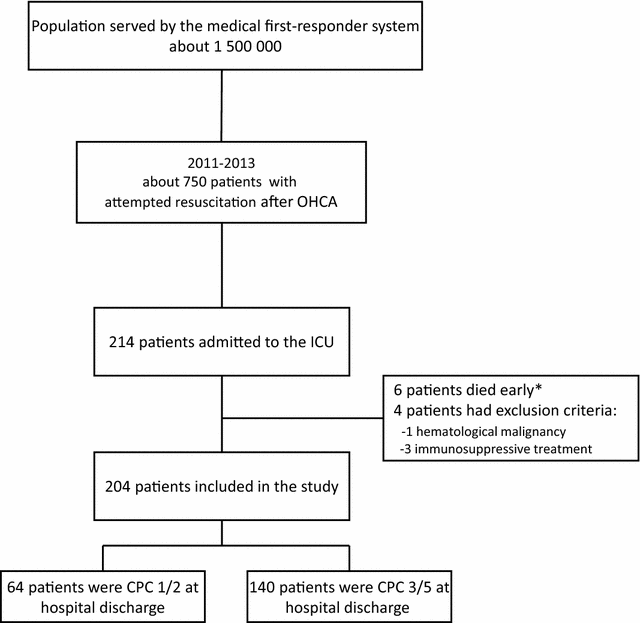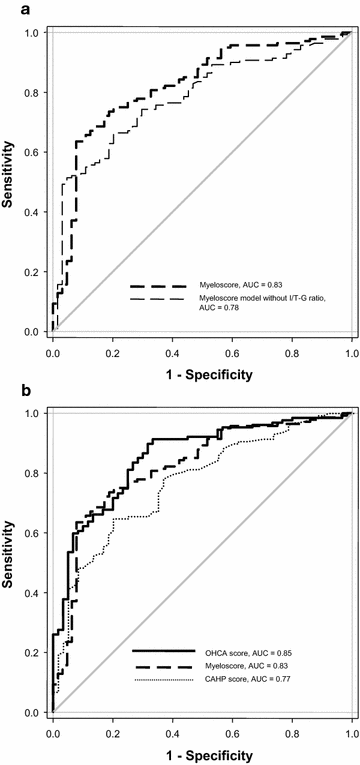Immature/total granulocyte ratio improves early prediction of neurological outcome after out-of-hospital cardiac arrest: the MyeloScore study
- PMID: 27422256
- PMCID: PMC4947062
- DOI: 10.1186/s13613-016-0170-4
Immature/total granulocyte ratio improves early prediction of neurological outcome after out-of-hospital cardiac arrest: the MyeloScore study
Abstract
Background: Elevation of the immature/total granulocyte (I/T-G) ratio has been reported after out-of-hospital cardiac arrest (OHCA). Our purpose here was to evaluate the prognostic significance of the I/T-G ratio and to investigate whether the I/T-G ratio improves neurological outcome prediction after OHCA.
Methods: This single-center prospective cohort study included consecutive immunocompetent patients admitted to our intensive care unit over a 3-year period (2012-2014) after successfully resuscitated OHCA. The I/T-G ratio was determined in blood samples collected at admission.
Results: We studied 204 patients (77 % male, median age, 58 [48-67] years), of whom 64 % had a suspected cardiac cause of OHCA, 62 % died in the unit, and 31.5 % survived with good cerebral function. Independent outcome predictors by multivariate analysis were age, first shockable rhythm, bystander-initiated resuscitation, and I/T-G ratio. Compared to the model computed without the I/T-G ratio, the model with the ratio performed significantly better [areas under the ROC curves (AUCs), 0.78 vs. 0.83, respectively; P = 0.04]. These items were used to develop the MyeloScore equation: ([0.47 × I/T-G ratio] + [0.023 × age in years]) - 1.26 if initial VF/VT - 1.1 if bystander-initiated CPR. The MyeloScore predicted neurological outcomes with similar accuracy to the previously reported OHCA score (0.83 and 0.85, respectively; P = 0.6). The ROC-AUC was 0.84, providing external validation of the MyeloScore.
Conclusions: The I/T-G ratio independently predicts neurological outcome after OHCA and, when added to other known risk factors, improves neurological outcome prediction. The clinical performance of the MyeloScore requires evaluation in a prospective study.
Keywords: Biological markers; Disability; Out-of-hospital cardiac arrest; Prognosis; Survival.
Figures


Similar articles
-
Immature/total granulocyte ratio: a promising tool to assess the severity and the outcome of post-cardiac arrest syndrome.Resuscitation. 2014 Aug;85(8):1115-9. doi: 10.1016/j.resuscitation.2014.04.017. Epub 2014 Apr 30. Resuscitation. 2014. PMID: 24795281
-
[Investigation of out-of-hospital cardiac arrest in Zhengzhou City and the risk factors of prognosis of cardiopulmonary resuscitation: case analysis for 2016-2018].Zhonghua Wei Zhong Bing Ji Jiu Yi Xue. 2019 Apr;31(4):439-443. doi: 10.3760/cma.j.issn.2095-4352.2019.04.013. Zhonghua Wei Zhong Bing Ji Jiu Yi Xue. 2019. PMID: 31109417 Chinese.
-
Ten-year experience of an invasive cardiology centre with out-of-hospital cardiac arrest patients admitted for urgent coronary angiography.Kardiol Pol. 2014;72(8):687-99. doi: 10.5603/KP.a2014.0088. Epub 2014 May 20. Kardiol Pol. 2014. PMID: 24846357
-
Conversion to shockable rhythms during resuscitation and survival for out-of hospital cardiac arrest.Am J Emerg Med. 2017 Feb;35(2):206-213. doi: 10.1016/j.ajem.2016.10.042. Epub 2016 Oct 25. Am J Emerg Med. 2017. PMID: 27810251
-
Serum neurofilament measurement improves clinical risk scores for outcome prediction after cardiac arrest: results of a prospective study.Crit Care. 2021 Jan 20;25(1):32. doi: 10.1186/s13054-021-03459-y. Crit Care. 2021. PMID: 33472689 Free PMC article.
Cited by
-
Comparison of different clinical risk scores to predict long-term survival and neurological outcome in adults after cardiac arrest: results from a prospective cohort study.Ann Intensive Care. 2022 Aug 17;12(1):77. doi: 10.1186/s13613-022-01048-y. Ann Intensive Care. 2022. PMID: 35978065 Free PMC article.
-
External validation of the PROLOGUE score to predict neurological outcome in adult patients after cardiac arrest: a prospective cohort study.Scand J Trauma Resusc Emerg Med. 2023 Apr 4;31(1):16. doi: 10.1186/s13049-023-01081-1. Scand J Trauma Resusc Emerg Med. 2023. PMID: 37016393 Free PMC article.
-
Predicting neurological outcome in adult patients with cardiac arrest: systematic review and meta-analysis of prediction model performance.Crit Care. 2022 Dec 11;26(1):382. doi: 10.1186/s13054-022-04263-y. Crit Care. 2022. PMID: 36503620 Free PMC article.
-
Gamma-Glutamyl Transpeptidase to Platelet Ratio: A New Inflammatory Marker Associated with Outcomes after Cardiac Arrest.Mediators Inflamm. 2021 Aug 13;2021:5537966. doi: 10.1155/2021/5537966. eCollection 2021. Mediators Inflamm. 2021. PMID: 34434073 Free PMC article.
-
Prognostic value of the delta neutrophil index in pediatric cardiac arrest.Sci Rep. 2020 Feb 26;10(1):3497. doi: 10.1038/s41598-020-60126-y. Sci Rep. 2020. PMID: 32103031 Free PMC article.
References
-
- Sans S, Kesteloot H, Kromhout D. The burden of cardiovascular diseases mortality in Europe. Task Force of the European Society of Cardiology on Cardiovascular Mortality and Morbidity Statistics in Europe. Eur Heart J. 1997;18(12):1231–1248. doi: 10.1093/oxfordjournals.eurheartj.a015434. - DOI - PubMed
-
- Kudenchuk PJ, Sandroni C, Drinhaus HR, Böttiger BW, Cariou A, Sunde K, Dworschak M, Taccone FS, Deye N, Friberg H, Laureys S, Ledoux D, Oddo M, Legriel S, Hantson P, Diehl JL, Laterre PF. Breakthrough in cardiac arrest: reports from the 4th Paris International Conference. Ann Intensive Care. 2015;5(1):22. doi: 10.1186/s13613-015-0064-x. - DOI - PMC - PubMed
LinkOut - more resources
Full Text Sources
Other Literature Sources

